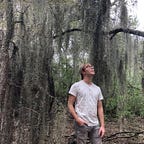Compression and Release
Typically, one has to register (and pay) for a tour of Frank Lloyd Wright’s home and studio in Oak Park, Illinois. However, I jumped in line as a tour group entered through the front door — slipping right in, free of charge.
I’m certainly an admirer of Wright’s work, and being in Chicago has allowed me to get up close with many of his buildings. Last year, I toured the Robie House during an architecture festival. The Rookery — the lobby of which Wright designed — is only a few blocks from campus. And this October, I stumbled upon the Fabyan Estate in Geneva, which he redesigned.
But stepping into his home was an altogether rare and unique experience, not just because it was where the Prairie School founder worked and lived for two decades, but because it happened on lunch break during a film shoot three houses down. Not only did it serve as a welcome respite from a twelve hour workday, but Wright’s design wound up reinforcing a lesson I was already learning.
Over the four days I was on set, I had to almost completely abandon my writing. I mentioned this in my last article, but briefly: I struggled to focus on that project alone without all my other responsibilities banging around in my head.
But it failed to hinder me. In fact, immediately after the shoot ended, so did — I believe — my creative rut. I sat down the next day and began to work on a screenplay, making significant headway. Then, like a dam breaking, an idea came to me yesterday, and in a matter of hours I’d restructured the whole script. All of a sudden, everything clicked.
Wright abided by a design principle he referred to as “compression and release.” In his structures, before entering an open, spacious area, one must first pass through a narrow, constricting one. This idea is most apparent in moving from the former drafting room in his home to the children’s playroom.
The drafting room, once an open, sunlit space, is divided by a 3/4 wall in the center, halving the square footage. From this smaller space one transitions into a long, dim hallway with an arched ceiling. At the very end there is a bright light, and upon stepping out, the playroom blossoms before you, vaulted ceiling and bands of windows creating an illuminating and inviting atmosphere.
The change is so abrupt and surprising that you might blink, temporarily blinded by the difference in space and brightness. Then, a moment of relief, as if escaping a nightmare.
Yesterday, after weeks of languishing in a creative rut and what felt like years poured into a film shoot, I was struck by an idea. Grabbing my notebook, I bled ink until I had solved a crucial problem in my story that had arrested my forward motion for weeks.
From the tunneling darkness of (what I dare call) writer’s block, I emerged into a bright, airy creative…shall I say “meadow?” Searching for the opposite of “rut” here…Anyway, the tension in my shoulders fizzled, and the best part is: I didn’t even ask for it.
Sure, I’d been trying to find a detour past this inspiration roadblock, but I eventually discovered it by doing the exact opposite: focusing on something else.
Instead, I donned the blinders and worked solely on a single project. One foot in front of the other, I moved step by step down the dim hallway, eyes ahead. Then, lo and behold, I arrived at a place open, inviting, and — liberating. I was freed from my creative crisis. Now, to move forward.
This isn’t to say I won’t encounter such a struggle down the road. The path to completing a project is lined with such creative ruts; you’re bound to fall into one now and again. But down in the trenches, with walls on all sides, don’t think about climbing up and running headlong across no-man’s-land. Keep your eyes front and remember:
Compression…release.
A little blind focus leads to new sight.
